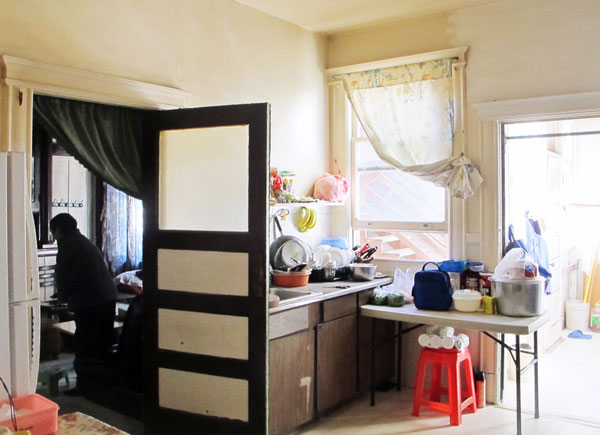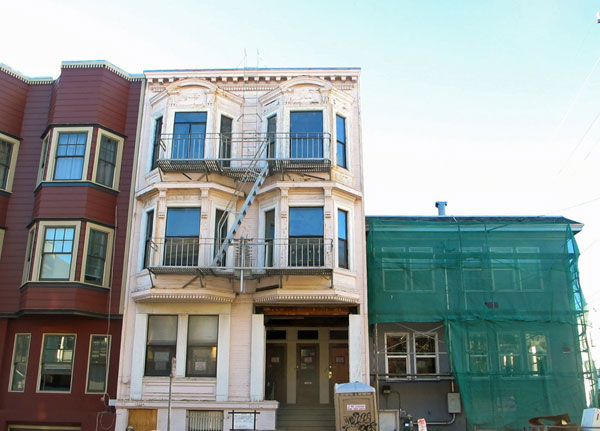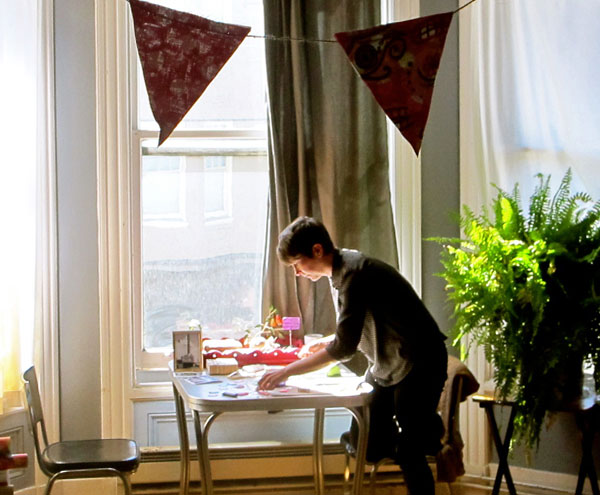[Editor’s note: Beautiful, eclectic, iconic, Pacific harbour towns: the words describe both Vancouver and San Francisco. Yet the two cities have taken different directions in the treatment of renters. Today, Tyee Solutions Society housing reporter Jackie Wong looks at San Francisco's legal protections for tenants, which some Vancouverites may envy -- though they still may not be enough to fight the profitable economics of redevelopment. Find the series so far here.]
Amy Farah Weiss thought she'd landed her dream home when she moved into a beautiful San Francisco apartment near the diverse, centrally-located Divisadero Corridor in 2008. "I loved it, and I loved my housemates," the 36-year-old says. She paid $750 for her spot in the space she shared with two people. City rent control assured her, she says, that she could afford to live there for years.
"If you had asked me two years ago where I was going to to be in 10 years, I would have said in that apartment," she says. "I was thinking I was going to live in that place forever."
It turned out not to be so. Weiss butted heads with her landlord when, according to her, she tried to assert tenant rights that the landlord refused to acknowledge. Weiss was evicted, sharing a fate that's befallen thousands of other San Francisco renters.
Getting turfed from her home was heartbreaking. She'd grown attached to the place and had started to put down roots and plan her future. Forced to leave, she found herself asking: "When I rent, am I allowed to say that I belong to this neighbourhood and it belongs to me? I haven't quite gotten that message. But if you own property, you can say that."
A double standard of citizenship between renters and property owners has been with us a long time. Early in Canada's history, only the latter could vote (if they were also male). To this day, it's a widely-held belief that home owners have a stronger stake in their communities than renters and therefore make better citizens.
But that idea discounts more than half of us: the renting majority. In Vancouver it's 53 per cent of all households. In San Francisco it's nearly two out of three: 65 per cent of San Francisco households rent.
So are renters really civic non-entities? Not if Weiss is any example.
Last year Weiss founded a non-profit to explore the potential power behind the citizen renter. Her group, called Neighbors Developing Divisadero (NDD), brings new and longtime residents, especially renters, together to support inclusive, enriching and sustainable development in the rapidly-changing Divisadero Corridor and several surrounding neighbourhoods including the Western Addition, North of the Panhandle and Alamo Square.
The group cares for a community garden where it holds neighbourhood events. It's also leading a local campaign to save the Harding Theater, an historic vaudeville house reminiscent of Vancouver's Pantages, from demolition.
Weiss's group is just one of a rich and flourishing ecology of pro-renter groups in the Bay Area. The 43-year-old San Francisco Tenant Union has two paid staff, nearly three dozen volunteer counsellors and publishes an annually updated Tenants Rights Handbook. The current edition runs to 315 pages. Not far from the union's headquarters, in the historically working-class Mission district (reminiscent of Vancouver's Commercial Drive), the San Francisco Housing Rights Committee provides tenant counselling services to about 5,000 low-income renters per year.
Weiss's goal, she says, is to engender a sense of empowerment and belonging among local renting residents that she hopes will fortify them to resist mounting pressures from investors to redevelop the neighbourhood for a wealthier demographic.
From rent control, strong neighbourhoods
Central to her message is the idea that controlled-rent tenants can be just as committed urban citizens as their mortgage-paying neighbours.
They may not own their land or airspace the way title-holders do, she concedes. But tenants who live in rent-controlled apartments have a strong extra incentive to invest in their community. Predictable, modest rent increases give a reason to stay put, Weiss argues, and social and personal investment by long-term residents -- as well as financial investment -- are what neighbourhoods need to thrive as inclusive spaces for everyone.

"The more time I'm here, the better deal [on rent] I'm getting, so I'm going to continue staying," Weiss says of her own experience in the new rent-controlled apartment she found this spring near the Divisadero Corridor for a little over $800 a month. "Rent control ties you to a place."
For many of those fortunate San Franciscans living in one of the 183,500 rent-controlled apartments in the city -- that's 83 per cent of the city's entire rental housing stock -- it would take a major life change or an eviction to get them to leave. For some, affordable accommodation can even feel a little like a pair of golden handcuffs.
The Castro is an iconic San Francisco neighbourhood about 10 blocks south of where Weiss lives. It's also been one of the most prominent sites of gay activism in the United States, amassing political influence due in large part to its affordable rents that became a magnet for gay and transgender youth fleeing hostile homes and homophobic communities in the rest of America.
Tommi Mecca has rented in the Castro for the 21 years he's lived in San Francisco. He came here from Philadelphia at 42, reeling from the loss of both parents within a year of each other and on the heels of a decade burdened by the deaths of most of his friends from AIDS. Like other gay men who lived through the AIDS crisis, Mecca was traumatized by his own survival. "I came through the epidemic [HIV] negative," he says. "That's a thing I was feeling a lot of guilt about."
Moving to the Castro was transformative and healing. A minimum-wage job at a bookstore easily covered his share of the controlled rent in a two-bedroom apartment, and left him time to volunteer in the housing justice movement.
"It was a neighbourhood that was so alive with everything, not just the activism, but life -- celebrating life and being alive," he remembers. "And having a freedom. You could live cheap." Affordable living was central to the political vitality of the Castro of the past, Mecca says. Protection under rent control meant landlords were limited in how much they could raise rents each year (for 2013, it's 1.9 per cent).
Now that's disappearing, as dwellings are removed from the coverage of San Francisco's Rent Control and Stabilization Ordinance. "The people moving into the Castro today are very upscale. The rents are among the highest in the city," he says. "People with AIDS are being pushed out of their long-term apartments left and right."
Mecca is 62 now, and still living in the same apartment. Even though his minimum-wage bookstore days are behind him and he's got a steady job as counselling director at the San Francisco Housing Rights Committee, Mecca says he can't afford to retire. Nor can he afford to move out of his apartment. Thanks to two decades of controlled rent, he still only pays $566 a month for a shared two-bedroom. He's well aware that he couldn't afford the going market rents in the Castro. "My apartment's worth about $3,000 [a month] now. It's absolutely immoral," he says.
Immoral or not, the growing gap between the income a property can return to its owner under rent-control versus the open market is the powerful force behind a wave of conversions that have taken apartments out from under rent control. Mass evictions conducted using the Ellis Act, a California state law, have tripled since the start of this year, according to the San Francisco Tenants Union's Ted Gullicksen. "There's no defence to it whatsoever. It's very effective," Gullicksen says. The Ellis Act allows landlords to get out of the landlord business by evicting all tenants from their building.
Some landlords leaving their jobs under the Ellis Act sell their former buildings to real estate developers, and both parties turn a profit. Tenant advocates like Gullicksen point to the Act as a primary culprit for depleting San Francisco's stock of affordable, rent-controlled housing.
For some, nowhere else to go
Six kilometres northeast of the Castro, the lively hum of restaurant patios lining fashionable Nob Hill's Polk Street stops abruptly at the corner of Jackson Street. The quiet bulk of a Chinese Community Church punctuates a nondescript residential block.
Here, 73-year-old Gum Gee Lee lives in a rent-controlled two-bedroom up a narrow flight of stairs across the street from the church. It's the only home she's known since immigrating to the United States with her family from China in 1979, the same year the Rent Control Ordinance came into effect.
She raised seven children in the cramped space, working at different times as a seamstress, dishwasher and caregiver, while her husband worked in restaurants and later as a cleaner at the Marriott Hotel downtown. "It was ample space for us all. I considered myself very fortunate," she says in Cantonese. "I was always very happy here."
Now the couple shares the rooms with their last daughter at home, a 48-year-old with a developmental disability.

When the family moved in 34 years ago, they paid about $325 a month for their apartment. Earlier this year, they were still paying only $778, a fraction of the $2,800 a month that a one-bedroom in the centrally-located neighbourhood fetches on the open market today.
But Lee's days in the apartment are numbered. A year ago she received an eviction notice: her building's owner sold the building for $1.2 million to a condominium developer. The former landlord stepped out of the residential rental market altogether which, under the Ellis Act, allowed him to evict all tenants. On Sept. 25, the Lees were ordered to leave their home of three decades.
Benefits somewhat soften the blow. Tenants evicted under the Ellis Act are entitled to relocation payments: a renter who has lived in a place for a year or more is supposed to receive $5,153 -- half on the event of eviction notice, half when they move out. Seniors and people with disabilities are entitled to another $3,436 each. Eviction orders also have to give tenants at least 120 days' notice, with senior and disabled tenants getting a full year's warning.
By contrast, tenants being lawfully evicted in British Columbia are entitled to compensation of one month's rent. In Vancouver, that could amount to $1,200 to $1,500 for a typical one-bedroom apartment, about a fifth of what renters in San Francisco receive for relocating.
Despite San Francisco's comparatively generous support and year-long advance notice, by the end of last month the Lees had overstayed their tenancy and faced forcible removal from the apartment. At that point, the city's large and influential tenant advocacy community swung into action.
About a hundred people attended an all-day demonstration at the family's apartment, which attracted local and national media coverage. San Francisco's Mayor, Ed Lee, called the landlord on their behalf. And the Chinatown Community Development Center (CCDC) redoubled its year-long effort to find the family a new home.

Lee was grateful, but not entirely optimistic. "I've searched so many places," she said. CCDC housing support workers "have helped me apply for so many housing opportunities. But I haven't been lucky. My name doesn't get drawn in the lotteries."
Her luck may soon change. Some San Francisco supervisors (the equivalent of Vancouver city councillors) have called for Ellis Act evictees to jump to the head of wait lists for city-subsidized affordable housing.
The response to the Lees' predicament reflects San Francisco's vigorous tenant-support agencies, pro-tenant local politicians and large renter majority. Yet despite a civic identity built in part on tenant clout, the Lees aren't the only San Francisco renters being pushed aside.
Says Maria Zamudio, a housing rights organizer for Causa Justa, a multi-ethnic social justice organization: "Our stock of deeply affordable housing, which is rent-controlled housing stock, we're losing it. They're being taken off the rental market, partly because units are being converted into condos, or they're being brought up to market-rate rent."
A 'backdoor' for controlled-rent leakage
San Francisco's tenant-positive rental ordinance turns out to have a backdoor. It limits the amount the landlord of a covered building or unit may raise its rent each year. But it lacks vacancy control. That means that when a tenant, voluntarily or under inducement, moves out of a rent-controlled unit, the landlord can raise its rents to whatever the market will bear without regard for the permitted annual increase.
(The same is true for Vancouver. Though all rental units in B.C. -- not just some as in San Francisco -- are subject to annual limits on rent increases, when a tenant vacates a unit a landlord may raise the rents as much as they wish.)
Like other observers, Zamadio blames deep-pocketed techsters for luring landlords to encourage their tenants in rent-controlled units to depart.
"The rental market has become so saturated by all of the people that the tech boom has brought into our city. It has been not only saturated with people, but saturated with money," Zamudio says. "It's not uncommon to go to an open house and have 20 people there for one two-bedroom apartment. And have half those people offer $1,000 more than the asking price, right then and there. Landlords are going to take whatever's given to them."
But, she points out, "that inflates the cost of housing overall."
Back in Amy Farah Weiss' Divisadero apartment, the indie rock band Idiot Glee plays while she makes a banner for a friend's birthday party. Like Mecca, she's a non-profit worker living in relative poverty, making $1,200 a month as a patient consultant for a Vancouver-esque medical cannabis dispensary.
It's a lifestyle San Francisco has allowed her. "I've lived for the last five years in San Francisco [earning] at least under $20,000, and some years under $15,000," she says. She's yet to see a paycheque from the hundreds of hours she's dedicated to Neighbors Developing Divisadero.
"I could find a job where I was making a decent living," Weiss says. "But I'm willing to struggle to do something I love."
Tomorrow: (Re-)developers are breathing new life into neighbourhoods in both Vancouver and San Francisco. But who are they for? ![]()
Read more: Urban Planning + Architecture

















Tyee Commenting Guidelines
Comments that violate guidelines risk being deleted, and violations may result in a temporary or permanent user ban. Maintain the spirit of good conversation to stay in the discussion.
*Please note The Tyee is not a forum for spreading misinformation about COVID-19, denying its existence or minimizing its risk to public health.
Do:
Do not: